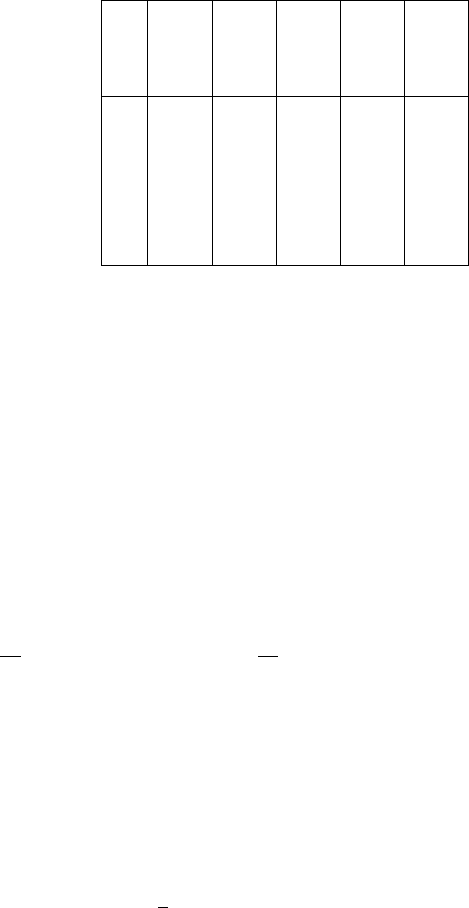Myint Tyn U., Debnath L. Linear Partial Differential Equations for Scientists and Engineers
Подождите немного. Документ загружается.


14.4 Explicit Finite Difference Methods 611
than one unless |p
1
| = |p
2
| = 1. Thus, the scheme is unstable as s →∞if
the modulus of one of the roots exceeds unity.
On the other hand, when −1 ≤ b ≤ 1, b
2
≤ 1, then |p
1
| = |p
2
| =1.
Thus, the finite difference scheme is stable provided −1 ≤ b ≤ 1, which
leads to the useful condition for stability as b ≥−1that
ε
2
≤ cosec
2
αh
2
. (14.4.12)
This shows the dependence of the stability limit on the space-grid size h.
However, this stability condition is always true if ε
2
≤ 1.
Example 14.4.1. Find the explicit finite difference solution of the wave equa-
tion
u
tt
− u
xx
=0, 0 <x<1,t>0,
with the boundary conditions
u (0,t)=u (1,t)=0,t≥ 0,
and the initial conditions
u (x , 0) = sin πx, u
t
(x, 0) = 0, 0 ≤ x ≤ 1.
Compare the numerical solution with the analytical solution u (x, t)=
cos πt sin πx at several p oi nts.
The expli cit finite difference approximation to the wave equation with
ε =(k/h) = 1 is f oun d from (14.4.3) in the form
u
i,j+1
= u
i−1,j
+ u
i+1,j
− u
i,j−1
,j≥ 1.
The problem is symmetric with respect to x =
1
2
, so we need to calculate
the solution only for 0 ≤ x ≤
1
2
. We take h = k =
1
10
=0.1. The bound-
ary conditions give u
0,j
=0forj =0, 1, 2, 3, 4, 5. The initial condition
u
t
(x, 0) = 0 yields
u
t
(x, 0) =
1
2
(u
i,1
− u
i,−1
)=0,
or,
u
i,1
= u
i,−1
.
The explicit formula with j = 0 gives
u
i,1
=
1
2
(u
i−1,0
+ u
i+1,0
) ,i=1, 2, 3, 4, 5.
Thus,

612 14 Numerical and Approximation Methods
u
1,1
=
1
2
(u
0,0
+ u
2,0
)=
1
2
u
2,0
=
1
2
sin (0.2π)=0.2939.
Similarly,
u
2,1
=0.5590,u
3,1
=0.7695,u
4,1
=0.9045,u
5,1
=0.9511.
We next use the basic explicit formula to compute
u
1,2
= u
0,1
+ u
2,1
− u
1,0
=0+0.5590 − 0.3090 = 0.2500,
u
2,2
= u
1,1
+ u
3,1
− u
2,0
=0.2939 + 0.7695 − 0.5878 = 0.4756.
Similarly, we compute other values for u
i,j
which are shown in Table 14.4.1.
The analytical solu tions at (x, t)=(0.1, 0.1) and (0.2, 0.3) are given by
u (0.1, 0.1) = cos (0.1π)sin(0.1π)=(0.9511) (0.3090) = 0.2939,
u (0.2, 0.2) = cos (0.2π)sin(0.2π)=(0.8090) (0.5878) = 0.4577,
u (0.2, 0.3) = cos (0.3π)sin(0.2π)=(0.5878) (0.5878) = 0.3455.
Comparison of the analytical solutions with the above finite difference
solutions shows that the latter results are very accurate.
(B) Parabolic Equations
As a prototype diffusion problem, we consider
u
t
= κu
xx
, 0 <x<1,t>0, (14.4.13)
u (0,t)=u (1,t)=0, for all t, (14.4.14)
u (x , 0) = f (x) , for all x in (0, 1) , (14.4.15)
where f (x) is a given f un ction.
Table 14.4.1.
i 0 1 2 3 4 5
x 0.0 0.1 0.2 0.3 0.4 0.5
jt
10.1 0 0.2939 0.5590 0. 7695 0.9045 0.9511
20.2 0 0.2500 0.4577 0. 6545 0.7695 0.8090
30.3 0 0.1817 0.3455 0. 4756 0.5590 0.5878
40.4 0 0.9045 0.7695 0. 2500 0.2939 0.3090
50.5 0 0 0 0 0 0

14.4 Explicit Finite Difference Methods 613
The explicit finite difference approximation to (14.4.13) is
1
k
(u
i,j+1
− u
i,j
)=
κ
h
2
(u
i+1,j
− 2 u
i,j
+ u
i−1,j
) , (14.4.16)
or,
u
i,j+1
= ε (u
i+1,j
+ u
i−1,j
)+(1− 2 ε) u
i,j
, (14.4.17)
where ε =
κk/h
2
.
This explicit finite difference formula gives approximate values of u on
t =(j +1)k in terms of values on t = jk with given u
i,0
= f
i
.Thus,u
i,j
can be obtained for all j by successive use of (14.4.17).
The problems of stability and convergence of the parabolic equation are
similar to those of the wave equation. It can be shown that the solution of
the finite difference equation converges to that of the differential equation
system (14.4.13)–(14.4.15) as h and k tend to zero provided ε ≤
1
2
.
In particular, when ε =
1
2
, equation (14.4.17) takes a simple form
u
i,j+1
=
1
2
(u
i+1,j
+ u
i−1,j
) . (14.4.18)
This is called the Bender–Schmidt explicit formula which determines the
solution at (x
i
,t
j+1
) as the mean of the values at the grid points (i +
1,j).
However, more accurate results can be found from (14.4.17) for ε<
1
2
.
To investigate the stability of the numerical scheme, we assume that the
error function is
e
r,s
=exp(iαrh) p
s
, (14.4.19)
where p = e
βk
. The error function and u
rs
satisfy the same difference
equation. Hence, we substitute (14.4.19) into (14.4.17) to obtain
p =1− 4 ε sin
2
αh
2
. (14.4.20)
Clearly, p is always less than 1 because ε>0. If p ≥ 0, the function given
by (14.4.19) will decay steadily as s = j →∞.If−1 <p<0, then the
solution will have a decaying amplitude as s →∞. Therefore, the finite
difference scheme will be stable if p>−1, that is, if
0 <ε≤
1
2
cosec
2
αh
2
. (14.4.21)
This shows that the stability limit depends on h. However, in view of the
inequality
ε ≤
1
2
≤
1
2
cosec
2
αh
2
,
we conclude that the stability condition is ε ≤
1
2
. Finally, if p<−1, the
solution oscillates with increasing amplitude as s →∞, and hence, the
scheme will be unstable for ε>
1
2
.

614 14 Numerical and Approximation Methods
Example 14.4.2. Show that the Richardson explicit finite difference scheme
for (14.4.13) is unconditionally unstable.
The Richardson finite d ifference approximation to (14.4.13) is
1
2k
(u
i,j+1
− u
i,j−1
)=
κ
h
2
(u
i+1,j
− 2 u
i,j
+ u
i−1,j
) . (14.4.22)
To establish the instability of this equation, we use the Fourier method
and assume that
e
r,s
=exp(iαrh) p
s
,p= e
βk
.
This function satisfies the Richardson difference equation as does u
r,s
. Con-
sequently,
p −
1
p
= −8 ε sin
2
αh
2
,
or
p
2
+8pεsin
2
αh
2
− 1=0.
This quadratic equation has two roots
p
1
,p
2
= −4 ε sin
2
αh
2
+
1+16ε
2
sin
4
αh
2
1
2
, (14.4.23)
or
p
1
,p
2
=+
1 − 4 ε sin
2
αh
2
1
+2ε sin
2
αh
2
+ O
ε
4
.
This gives |p
1
|≤1and
|p
2
| > 1+4ε sin
2
αh
2
> 1
for all positive ε and, consequently, the Richardson scheme is always un-
stable.
The unstable feature of the Richardson scheme can be eliminated by
replacing u
i,j
with
1
2
(u
i,j+1
+ u
i,j−1
) in (14.4.22), which now becomes
(1 + 2 ε) u
i,j+1
=2ε (u
i+1,j
+ u
i−1,j
)+(1− 2 ε) u
i,j−1
. (14.4.24)
This is called the Du Fort–Frankel explicit algorithm,anditcanbe
shown to be stable for all ε.

14.4 Explicit Finite Difference Methods 615
Example 14.4.3. Prove that the solution of the finite difference equation for
the diffusion equation (14.4.13) i n −∞ <x<∞ with the initial condition
u (x , 0) = e
iαx
converges to the exact solution of (14.4.13) as h and k tend
to zero.
We obtain the exact solution of (14.4.13) by seeking a separable form
u (x , t)=e
iαx
v (t) ,
where v (t) is a function of t alone which is to be determined.
Substituting this solution into (14.4.13) gives
dv
dt
+ κα
2
v =0
which admits solutions
v (t)=Ae
−κα
2
t
,
where A is an integrating constant. The initial condition v (0) = 1 gives
A = 1. Hence,
u (x , t)=exp
iαx − α
2
κt
. (14.4.25)
We now solve the corresponding finite difference equation (14.4.17) by
replacing i, j with r, s. We seek a separable solution of the difference
equation
u
r,s
= e
iαrh
v
s
with the initial condition
u
r,0
= e
iαrh
v
0
, so that v
0
=1.
Substituting this solution into the finite difference equation (14.4.7)
yields
v
s+1
=
1 − 4 ε sin
2
αh
2
v
s
,v
0
=1,
so that the solution can b e obtained by a simple inspection as
v
s
=
1 − 4 ε sin
2
αh
2
s
, (14.4.26)
u
r,s
= e
iαrh
1 − 4ε sin
2
αh
2
s
, (14.4.27)
where ε =
κk/h
2
.
For small h,1− 4 ε sin
2
(αh/2) ∼ 1 − εα
2
h
2
so that 1 − εα
2
h
2
≈
exp
−εα
2
h
2
for small εα
2
h
2
= κα
2
k. Consequently, the final solution
becomes

616 14 Numerical and Approximation Methods
u
r,s
∼ e
iαrh−κα
2
ks
as h, k → 0. (14.4.28)
This is identical with the exact solution of the differential equation (14.4.13)
with rh = x and sk = t. This example shows that the finite difference
approximation is reasonably good.
Example 14.4.4. Calculate a finite difference solution of the initial boundary-
value problem
u
t
= u
xx
, 0 <x<1,t>0,
with the boundary conditions
u (0,t)=u (1,t)=0,t≥ 0,
and the initial condition
u (x , 0) = x (1 − x) , 0 ≤ x ≤ 1.
Compare the numerical solution with the exact analytical solution at
x =0.04 and t =0.02.
The explicit finite difference approximation to the parabolic equation is
u
i,j+1
= εu
i−1,j
+(1− 2 ε) u
i,j
+ εu
i+1,j
,
where ε =
k/h
2
. This gives the unknown value u
i,j+1
at the (i, j +1)th
grid point in terms of given values of u along the jth time row.
We set h =
1
5
and k =
1
100
so that ε =
k/h
2
=
1
4
and the above
formula becomes
u
i,j+1
=
1
4
(u
i−1,j
+2u
i,j
+ u
i+1,j
) .
With the notation u
i,0
= u (ih, 0), the initial condition gives
u
4,0
=0.16, and u
5,0
=0.
The boundary conditions yield u
0,j
= u (0,jk)=0andu
5,j
=
u (5h, jk)=u (1,jk)=0,forallj =0,1,2,....
Using these initial and boundary data, we calculate u
i,j
as follows:
u
1,1
=
1
4
(u
0,0
+2u
1,0
+ u
2,0
)=0.14,u
1,2
=
1
4
(u
0,1
+2u
1,1
+ u
2,1
)
=0.125,
u
2,1
=
1
4
(u
1,0
+2u
2,0
+ u
3,0
)=0.22,u
2,2
=
1
4
(u
1,1
+2u
2,1
+ u
3,1
)
=0.200,
u
3,1
=
1
4
(u
2,0
+2u
3,0
+ u
4,0
)=0.22,u
3,2
=
1
4
(u
2,1
+2u
3,1
+ u
4,1
)
=0.200,
u
4,1
=
1
4
(u
3,0
+2u
4,0
+ u
5,0
)=0.14,u
4,2
=
1
4
(u
3,1
+2u
4,1
+ u
5,1
)
=0.125,

14.4 Explicit Finite Difference Methods 617
u
1,3
=
1
4
(u
0,2
+2u
1,2
+ u
2,2
)=0.1125,u
1,4
=
1
4
(u
0,3
+2u
1,3
+ u
2,3
)
=0.1016,
u
2,3
=
1
4
(u
1,2
+2u
2,2
+ u
3,2
)=0.1813,u
2,4
=
1
4
(u
1,3
+2u
2,3
+ u
3,3
)
=0.1641,
u
3,3
=
1
4
(u
2,2
+2u
3,2
+ u
4,2
)=0.1813,u
3,4
=
1
4
(u
2,3
+2u
3,3
+ u
4,3
)
=0.1641,
u
4,3
=
1
4
(u
3,2
+2u
4,2
+ u
5,2
)=0.1125,u
4,4
=
1
4
(u
3,3
+2u
4,3
+ u
5,3
)
=0.1016.
The method of separation of variables gives the analytical solution of
the problem as
u (x , t)=
8
π
3
∞
n=0
1
(2n +1)
3
exp
"
−(2n +1)
2
π
2
t
#
sin (2n +1)πx.
This exact solution u (x, t)atx =0.4(i =2)andt =0.02 (j =2)gives
u ∼
8
3
1
1
3
exp
−0.02 π
2
sin (0.4) π +
1
3
3
exp
−0.18 π
2
sin (1.2) π
=0.2000.
The analytical solution is seen to be identical with the numerical value.
Example 14.4.5. Obtain the numerical solution of the initial boundary-
value problem
u
t
= κu
xx
, 0 ≤ x ≤ 1,t>0,
u (0,t)=1,u(1,t)=0,t≥ 0,
u (x , 0) = 0, 0 ≤ x ≤ 1.
We use the explicit finite-difference formula (14.4.17)
u
i.j+1
= ε (u
i+1,j
+ u
i−1,j
)+(1− 2 ε) u
i,j
,
where ε =
κk/h
2
.
We set h =0.25 =
1
4
and ε =
2
5
=0.4tocomputeu
i.j
for i, j =0,1,2,
3, 4 as follows:

618 14 Numerical and Approximation Methods
i 0 1 2 3 4
j
0 1.000 0.000 0.000 0.000 0.000
1 1.000 0.400 0.000 0.000 0.000
2 1.000 0.480 0.160 0.000 0.000
3 1.000 0.560 0.224 0.064 0.000
4 1.000 0.602 0.295 0.103 0.000
(C) Elliptic Equations
As a prototype boundary-value problem, we consider the Dirichlet problem
for the Laplace equation
∇
2
u ≡ u
xx
+ u
yy
=0, 0 ≤ x ≤ a, 0 ≤ y ≤ b, (14.4.29)
wherethevalueofu (x, y) is prescribed everywhere on the boundary of the
rectangular domain.
The r ectangul ar grid system is the most common and convenient system
for this problem. We choose the vertices of the rectangular domain as the
nodal points and set h = a/m and k = b/n where m and n are positive
integers so that th e domain is divided into mn subrectangles.
The finite difference approximation to the Laplace equation (14.4.29) is
1
h
2
(u
i+1,j
− 2u
i,j
+ u
i−1,j
)+
1
k
2
(u
i,j+1
− 2u
i,j
+ u
i,j−1
)=0,(14.4.30)
or,
2
h
2
+ k
2
u
i,j
= k
2
(u
i+1,j
+ u
i−1,j
)+h
2
(u
i,j+1
+ u
i,j−1
) , (14.4.31)
where 1 ≤ i ≤ m − 1and1≤ j ≤ n − 1.
The prescribed conditions on the boundary of the rectangular domain
determine the values u
0,j
, u
m,j
, u
i,0
,andu
i,n
. For a square grid system
(k = h), equation (14.4.30) becomes
u
i,j
=
1
4
(u
i+1,j
+ u
i−1,j
+ u
i,j+1
+ u
i,j−1
) . (14.4.32)
This means that the value of u at an interior point is equal to the average
of the value of u at four adjacent points. This is the well known mean value
theorem for harmonic f unction s that satisfy the Laplace equation.
As i and j vary, th e present scheme reduces to a set of (m − 1) (n − 1)
linear non-homogeneous algebraic equations for (m − 1) (n − 1) unknown
values of u at interior grid points. It can be shown the solution of the finite

14.4 Explicit Finite Difference Methods 619
difference equation (14.4.31) converges to the exact solution of the problem
as h, k → 0. The proof of the existence of a solution and its convergence
to the exact solution as h and k tend to zero is essentially based on the
Maximum Modulus Pri nciple. It follows from the finite difference equation
(14.4.30) or (14.4.31) that the val ue of |u| at any interior grid point does
not exceed its value at any of the four ad join ing no d al p oints. In other
words, the value of u at P
i,j
cannot exceed its values at the four adjoining
points P
i +
1,j
and P
i,j + 1
. The successive application of this argument at
all interior grid points leads to the conclusion that |u| at the interior grid
points cannot be greater than the maximum value of |u| on the boundary.
This may be recognized as the finite difference analogue of the Maximum
Modulus Principle discussed in Section 9.2. Thus, the success of the nu-
merical method is directly associated with the existence of the Maximum
Modulus Principle.
Clearly, the present numerical algorithm deals with a large numb er of
algebraic equations. Even though numerical accuracy can be improved by
making h and k sufficiently small, there is a major computational difficulty
involved in the numerical solution of a large number of equations. It is
possible to handle such a large number of algebraic equations by direct
methods or by iterative methods, but it would be very difficult to obtain
a numerical solution with sufficient accuracy. It is therefore necessary to
develop some alternative methods of solution that can be conveniently and
efficiently carried out on a computer.
In order to eliminate some of the d rawbacks stated above, one of the nu-
merical schemes, the Liebmann’s iterative method, is useful. In this method
values of u are first guessed for all interior grid points in addition to those
given as the boundary points on the edges of the given domain. These values
are denoted by u
(0)
i,j
where the superscript 0 indicates the zeroth iteration.
It is convenient to choose a square grid so that the simplified finite differ-
ence equation (14.4.32) can be used. The values of u are calculated for the
next iteration by using (14.4.32) at every interior point based on the values
of u at the present iteration. The sequence of computation starts from the
interior grid point located at the lowest left corner, proceeds upward un-
til reaching the top, and then goes to the bottom of the next vertical line
on the right. This process is repeated until the n ew value of u at the last
interior grid point at the upper right corner has been obtained.
At the starting point, formula (14.4.32) gives
u
(1)
2,2
=
1
4
u
(0)
3,2
+ u
(0)
1,2
+ u
(0)
2,3
+ u
(0)
2,1
, (14.4.33)
where u
(0)
1,2
and u
(0)
2,1
are boundary values which remain constant during
the iteration process. They may be replaced, respectively, with u
(1)
1,2
, u
(1)
2,1
in
(14.4.33). The computation at the next step involves u
(0)
2,2
. Since an improved
value u
(1)
2,2
is available at this time, it will be utilized instead. Hence,

620 14 Numerical and Approximation Methods
u
(1)
2,3
=
1
4
u
(0)
3,3
+ u
(1)
1,3
+ u
(0)
2,4
+ u
(1)
2,2
, (14.4.34)
where u
(1)
1,3
is used to replace the constant boundary value u
(0)
1,3
.
We repeat this argument to obtain a general iteration formul a for com-
putation of u at step (n +1)
u
(n+1)
i,j
=
1
4
u
(n)
i+1,j
+ u
(n+1)
i−1,j
+ u
(n)
i,j+1
+ u
(n+1)
i,j−1
. (14.4.35)
This result is valid for any interior p oint, whether it is next to some bound-
ary point or not. If P
i,j
is a true point, the second and fourth terms on the
right side of (14.4.35) represent, respectively, the values of u at the grid
points to the left of and below that point. These values have already been
recomputed according to our scheme, and therefore, carry the superscript
(n + 1). Result (14.4.35) is known as the Liebmann (n +1)thiteration for-
mula. It can be proved that u
(n)
i,j
converges to u
i,j
as n →∞.
Another iteration sch eme similar to (14.4.35) is given by
u
(n+1)
i,j
=
1
4
u
(n)
i+1,j
+ u
(n)
i−1,j
+ u
(n)
i,j+1
+ u
(n)
i,j−1
. (14.4.36)
This is called the Richardson iteration formula, and it is also useful. How-
ever, this scheme converges more slowly than that based on (14.4.35).
One of the major difficulties of the above methods is the slow rate of con-
vergence. An improved numerical method, the Successive Over-Relaxation
(SOR) scheme gives a faster convergence than the Liebmann or Richardson
method in solving the Laplace (or the Poisson) equation. For a rectangular
domain of square grids, the successive iteration scheme is given by
u
(n+1)
i,j
= u
(n)
i,j
+
ω
4
u
(n+1)
i−1,j
+ u
(n)
i+1,j
+ u
(n+1)
i,j−1
+ u
(n)
i,j+1
− 4 u
(n)
i,j
, (14.4.37)
where ω is called the acceleration parameter (or relaxation factor)tobe
determined. In general, ω lies in the range 1 ≤ ω<2. The successive
iterations converge fairly rapidly to the desired solution f or 1 ≤ ω<2. The
most rapid rate of convergence i s achieved for the optimum value of ω.
Example 14.4.6. Obtain the standard five-point formula for the Poisson
equation
u
xx
+ u
yy
= −f (x, y)inD ⊂ R
2
with the prescribed value of u (x, y) on the boundary ∂D.
We assume that the domain D is covered by a system of squares with
sides of length h parallel to the x and y axes. Using the central difference
approximation to the Laplace operator, we obtain
1
h
2
(u
i+1,j
− 2 u
i,j
+ u
i−1,j
)+
1
h
2
(u
i,j+1
− 2 u
i,j
+ u
i,j−1
)=−f
i,j
,
